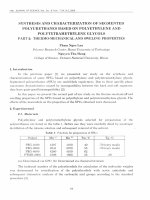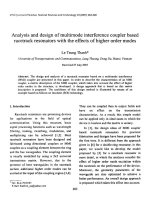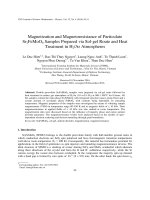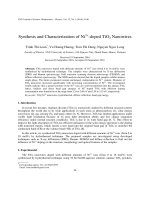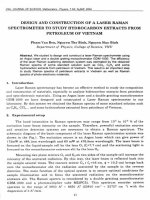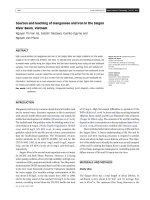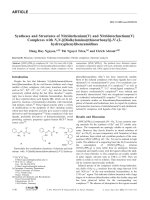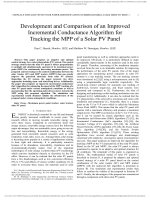DSpace at VNU: Research and Fabrication of an Antenna Based on Meta-materials with Negative Refractive Index
Bạn đang xem bản rút gọn của tài liệu. Xem và tải ngay bản đầy đủ của tài liệu tại đây (384.54 KB, 5 trang )
VNU Journal of Science: Mathematics – Physics, Vol. 32, No. 4 (2016) 63-67
Research and Fabrication of an Antenna Based
on Meta-materials with Negative Refractive Index
Dang Thi Thanh Thuy*
Faculty of Physics, VNU University of Science, 334 Nguyen Trai, Thanh Xuan, Hanoi, Vietnam
Received 18 October 2016
Revised 20 November 2016; Accepted 24 December 2016
Abstract: For fast developing materials science, the communication technology also introduces
new applications especially in the field of application of new materials and devices. Metamaterials with repeating structures that exhibit the negative refractive index, negative dielectric
constant, and negative magnetic permeability promise many benefits in the wireless
communication using a new class of microwave antennas. These novel antennas overcome
disadvantages of traditional microwave antennas while having smaller physical size, wider bandwidth and higher efficiency. In this paper we present the results of fabrication and test of metastructured antennas.
Keywords: Meta-material, antenna, meta-antenna, negative refractive index…
1. Introduction
Recent advances in the field of micro and nano materials processing allow us to create a new class
of artificial materials whose characteristics fall beyond the limits of conventional traditional materials.
The meta-materials are one class of the artificial materials that can be created from the traditional
materials by arranging the ordered structures of different shape and size [1]. Recent interest is focused
on the meta-materials having negative refractive index as these materials exhibit many important
characteristics not available in the traditional materials. Negative refractive index materials were
successfully fabricated for the first time in 2000 by Smith, while its properties were predicted
theoretically in 1968 by Veselago [2]. These materials themselves are a perfect combination of
electrical and magnetic components that simultaneously have the negative magnetic permeability (μ
<0) and electrical dielectric constant (ε <0) in the same frequency range. Thereby leading to the
electromagnetic properties and optical irregularities, including the inversion of Snell's law, the inverse
of the Doppler shift, and the inverse of Cherenkov emission.... By adjustment of the effective μ and ε
suitably the path of light rays can be bent when passing through the meta-materials while not being
reflected or scattered. Besides, a series of other critical applications which has also been suggested by
scientists is the application as frequency filters, resonators, sensors, absorbers, etc...
_______
Tel.: 84-1685292237
Email:
63
64
D.T.T. Thuy / VNU Journal of Science: Mathematics – Physics, Vol. 32, No. 4 (2016) 63-67
2. Negative refractive meta-material
As commonly known when a light ray arrives at the boundary separating two different
environments it will be refracted along a path 1-4 as given in Figure 1.
Figure 1. The light rays passing through the
separator shore [2, 8, 9].
Figure 2. The coordinate system of ε, μ [2, 8, 9]
However when the phase velocity and the group velocity are not in the same direction, the strange
thing happens that the beam will be deflected in the direction path 1-3. Therefore, if one wants to keep
the correct formula of refraction (i.e. the Snell law) sinφ/sinФ = n, then n < 0 because sinΦ < 0. We
have n = εµ so that: n . The case with the plus sign “+” applies when the material is
normal, it has ε > 0 and µ >0; the case with minus sign “-” applies when the material has both ε < 0
and µ < 0. From here we have the pairs of positive and negative values of (ε, μ) making up four
regions in the coordinate system of ε, μ.
Figure 3a. A electric material model [2, 8, 10]
Figure 3b. A plasma magnetic material model [2, 8, 10]
Negative refractive index materials are usually formed from the basic structures, which act as the
"atoms" in the materials. These "atoms" are grouped together repeatedly or not. They consist of two
main components which are electrical components and magnetic components. The electrical
components (electric metamaterial) generate the negative value of dielectric constant (ε <0). The
magnetic components generate the negative magnetic permeability (μ <0). One of the interesting
D.T.T. Thuy / VNU Journal of Science: Mathematics – Physics, Vol. 32, No. 4 (2016) 63-67
65
properties of materials with negative refractive index is 3 vectors of electromagnetic (E, H, k) waves
obey the left-handed rule. Thus, the materials with a negative refractive index are also known as the
left-handed metamaterials (LHMs). LHMs can be designed and built to operate on the desired
frequency band ranging from the microwave region to the far infrared, even closer to the visible light
region [3-5]
3. Fabrication of antenna on the basic of meta-material
We now focus on a simulation of meta-materials with a simple structure as given in Figure 4 [6-7].
While taking into account the number of unit cells, the change in the unit cell distance can be
monitored. From the original pad antenna we altered the structure of the active surface to the one of
the meta-structured materials.
Figure 4. Resonance characteristics depends on distance between unit cells
Each unit cell contains a pillar of copper of 3.5 µm in height and 1mm in size. To observe the
effect of changing distance between the unit cells we modeled 9 unit cells. Here we simulated 8
antennas with the unit cell distances equal to 0.5, 1, 1.5, 2, 2.5, 3, 3.5, 4 mm respectively while
keeping all other parameters of the sample antenna unchanged.
In Figure 4, a sample A has a distance d = 0.5 mm, B has d = 4 mm. These antennas are designed
on a glass substrate of size 2020 mm, and thickness 100 µm. Two copper faces have a thickness
equal 3.5 µm. The lower surface size is 1819 mm. The higher surface includes 9 unit cells of 1mm in
size and 3.5 µm in height. The distance between unit cells change from 0.5 to 4 mm. The voltage
supply line cross section is 100 µm and the area of the voltage supply contacting point is 22 mm.
Accordingly we fabricated two antennas on glass material utilizing the Cu surfaces and examined
the characteristics of these antenna responses.
66
D.T.T. Thuy / VNU Journal of Science: Mathematics – Physics, Vol. 32, No. 4 (2016) 63-67
a) A microtrip antenna and a meta-antenna.
b) Resonance characteristic of the microtrip antenna.
c) Resonance characteristic of the optimized metamaterial antenna.
Figure 5. Resonance characteristic of the microtrip antenna and meta-material antenna.
The results showed that for a resonance seen at 6.6 GHz the feedback coefficient is -19.27 dB. We
obtained 3 resonance peaks with a performance at 7.66 GHz with feedback coefficient of -34.2 dB. In
comparison with a modeled antenna with 9 unit cells the best resonance peak occurred at 6.8 GHz with
return loss -12.2 dB.
4. Conclusion
The fabrication and modeling simulation of a meta-materials based antenna, working in the
microwave region, has been discussed. The good agreements between the theoretical and experimental
results were achieved for the model antennas composed of finit number of separated square units in
the active surface. The results showed that the occurence of the meta-structure led to the improvement
D.T.T. Thuy / VNU Journal of Science: Mathematics – Physics, Vol. 32, No. 4 (2016) 63-67
67
of both band-width and gain for the antenna modelled. Therefore, the application of artificial materials
in the fabrication of microwave antenna overcome the disadvantages of the old strip-technology and
showed that the bandwidth could be improved as well as the performance of the antenna. This study
also suggested that a simple structured meta-materials based antenna can be easily fabricated by the
current technology available in Viet Nam. These results promised the application of new type of
antenna in manufacturing of novel communications devices.
Acknowledgement
This research is funded by the Vietnam National University, Hanoi (VNU) under project number
QG.15.12.
References
[1] N. W. Ashcroft, N. D. Mermin, “Solid State Physics”, Holt, Rinehart and Winston, (1976).
[2] S. N. Khanna, P. Jena, “Assembling crystals from clusters”, Phys. Rev. Lett.69, 1664–1667 (1992).
[3] Colburn J. S., and Rahmat-Samii Y. (1999), “Patch antennas on externally perforated high dielectric constant
substrates”, IEEE Trans. Antennas Propagat, pp. 1785–94.
[4] GA Deschamps,“Microstrip microwave antennas” presented at the 3rd USAF Symp. on Antennas, 1953;
"Microstrip and Printed Antennas: New Trends, Techniques and Applications" Ed. Debatosh Guha,Yahia M.M.
Antar. J. Wiley and Sons, 2011.
[5] Balanis CA. Antenna theory: Analysis and design, 3rd Ed., Wiley-Interscience; 2012.
[6] Christophe Caloz (2006), “Electromagnetic Metamaterials: Transmission line theory and microwave
applications”, John Wiley & Sons, Inc., Hoboken, New Jersey, Canada.
[7] Ansoft, LLC. An Introduction to HFSS: Fundamental Principles, Concepts and Use. An-soft, 2009.
[8] Shelby, R. A.; Smith, D. R.; Schultz, S. (2001). Experimental Verification of a Negative Index of Refraction.
Science 292 (5514): 77–79. 2001.
[9] Hsu, Yi-Jang; Huang, Yen-Chun; Lih, Jiann-Shing; Chern, Jyh-Long (2004). "Electromagnetic resonance in
deformed split ring resonators of left-handed meta-materials". Journal of Applied Physics 96 (4): 1979 (2004).
[10] WU, Q.; Pan, P.; Meng, F.-Y.; Li, L.-W.; Wu, J. (2007-01-31). "A novel flat lens horn antenna designed based on
zero refraction principle of metamaterials". Appl. Phys. A 87 (2): 151–156 (2007).


